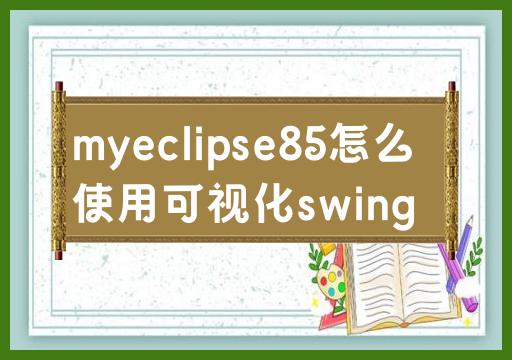
1. How to use visual Swing in MyEclipse 8.5?
In MyEclipse 8.5, using visual Swing for interface design is relatively simple. You can follow the following steps:
1. Open MyEclipse : Start MyEclipse 8.5 and enter the workbench.
2. Create a Java project: Select "File" in the workbench -> "New" - > "Project", select "Java Project" and click "Next". Fill in the project name and other information and click "Finish" to create the project.
3. Create a Swing form: Right-click the "src" directory in the project and select "New " -> "Other" -> "Swing Designer" -> "JFrame (Swing)", fill in the class name and other information, and click " Finish”.
4. Visual design: Open the generated Swing class file and select the "Design" view to create the Swing window in the visual interface. body design.
5. Add components: Drag the Swing component from the "Palette" on the left to the design interface, set properties, and adjust the layout .
6. Edit event: You can double-click the component in the design interface to enter the edit event and add the corresponding event processing code.
7. Save and run: After the design is completed, save the file and click the "Run" button on the toolbar or use the shortcut key to run.
Through these steps, you can visually design the Swing interface in MyEclipse 8.5.
2. How to use MyEclipse to directly design the interface?
MyEclipse provides the function of directly designing the interface, allowing users to design the interface visually. The following are general steps:
1. Open MyEclipse: Start MyEclipse and open the corresponding Java project.
2. Select the interface designer: Find the Java class that needs to be designed in the project, right-click and select "Open With" - > "WindowBuilder Editor".
3. Visual design: After entering the WindowBuilder editor, you can perform visual interface design in the "Design" view.
4. Add components: Drag components from the "Palette" on the left to the design interface, set properties, and adjust layout.
5. Edit events: Double-click the component or right-click and select "Events" to edit the event and add the corresponding event processing code.
6. Save and run: After the design is completed, save the file and click the "Run" button on the toolbar or use the shortcut key to run.
Through these steps, you can design the Java interface directly in MyEclipse.
3. MyEclipse visualizes HTML?
MyEclipse also provides visual design functions for HTML. The following are general usage steps:
1. Open MyEclipse: Start MyEclipse and open the corresponding Web project.
2. Select the HTML file: Find the HTML file that needs to be designed in the project, right-click and select "Open With" -> ; "Web Page Editor".
3. Visual design: After entering the Web Page Editor, you can perform visual HTML design in the "Design" view.
4. Add elements: Drag HTML elements from the "Palette" on the left to the design interface, set properties, and adjust layout .
5. Edit styles and scripts: You can edit the HTML source code in the "Source" view, or in the " Edit styles and scripts in CSS" and "Scripts" views.
6. Save and preview: After the design is completed, save the file and click the "Preview" button on the toolbar to preview.
Through these steps, you can visually design HTML pages in MyEclipse.
4. How to use MyEclipse to use visualization plug-ins?
MyEclipse integrates visual plug-ins, making it easier for users to design interfaces. The following are general usage steps:
1. Open MyEclipse: Start MyEclipse and open the corresponding project.
2. Select the plug-in view: Select "Window" in the workbench -> "Show View" -> "Other...", select "General" in the pop-up window -> "Palette".
3. Use plug-ins: Drag the "Palette" panel to the appropriate location and select the corresponding plug-in to design the visual interface.
4. Add components: Drag components from the plug-in panel to the design interface, set properties, and adjust layout.
5. Edit events: Double-click the component or right-click and select "Events" to edit the event and add the corresponding event processing code.
6. Save and run: After the design is completed, save the file and click the "Run" button on the toolbar or use the shortcut key to run.
Through these steps, you can use visual plug-ins in MyEclipse for more flexible interface design.
Summary
In MyEclipse, you can use visual methods to design Swing and Java interfaces, edit HTML pages, and conduct more flexible interface design through integrated visual plug-ins. . According to specific needs, choose the applicable method for interface design.

The above is the detailed content of How to use Swing for visual programming in MyEclipse8.5. For more information, please follow other related articles on the PHP Chinese website!
 Is Hongmeng system easy to use?
Is Hongmeng system easy to use?
 What is the difference between rabbitmq and kafka
What is the difference between rabbitmq and kafka
 How to solve the slow download problem of Baidu Netdisk
How to solve the slow download problem of Baidu Netdisk
 Does inflation rate have an impact on digital currencies?
Does inflation rate have an impact on digital currencies?
 What are the dos commands?
What are the dos commands?
 vue v-if
vue v-if
 Characteristics of two's complement arithmetic
Characteristics of two's complement arithmetic
 oracle database running sql method
oracle database running sql method




